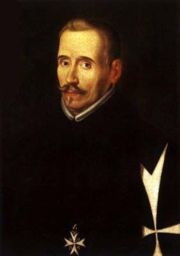
August 16, 2006, by Peter Kirwan
Capulets & Montagues (CAPITAL Centre) @ The Dell
Although my project is mainly concerned with the main performances of the Complete Works Festival, it’s impossible to ignore the fact that there’s a lot more going on in Stratford than what’s in the theatres. While no–one could possibly go to all of the talks, discussions, workshops and sideshows that are happening, it’s really interesting to get to some of them and see what’s going on around the main Festival.
I’m writing this blog on behalf of the CAPITAL Centre at the University of Warwick, and so after ‘2 Henry VI’ I stepped across the road in order to see CAPITAL‘s most high–profile contribution to the Festival– a student production of ‘Capulets & Montagues’ by Lope de Vega, a Spanish play based on the same material as ‘Romeo and Juliet’.
This was part of the ‘Fringe Festival’– a group of amateur productions being put on for free in The Dell, an outdoor space next to Holy Trinity Church– and it was good fun! A solid audience sat on blankets or (for the more hardcore of us) the grass, while a temporary stage backed on to the River Avon as the boats sailed past. There was an excellent atmosphere, a proper festival feel, and the fact that audience members could wander in and out turned it into a proper community event.
The production was mounted in four weeks, with a student cast and crew reaping the benefits of an RSC wardrobe and professional artists including director Heather Davies. The play itself is a tragicomedy, whose plot I won’t outline here, but in this version the Romeo and Juliet characters, Roselo and Julia, live and are accepted, the play ending in a triple wedding. It was interesting to see the similarities and differences in the treatment of the same material, much as ‘The Two Noble Kinsmen’ event allowed us to do.
Highlights included Karl Niklas and Rhiannon Stalinski as the very funny comic servants of the two leads, whose down–to–earth love contrasted nicely with the high romance of their betters, and some nicely–worked physical humour, including scenes of stumbling round dark tombs and riding cardboard horses to Ferrara. Overall, though, this was a team production, with the ensemble pulling together a smooth and well–choreographed tale on an outdoor stage to great effect.
The play itself is quite stylised, with a high amount of onstage exposition and some lengthy scenes of dialogue that sound artificial, but Davies’ direction kept it fresh and fast, the whole play lasting just over an hour and a half. It goes to London next week for a few performances, and it’s definitely worth a look if you’re in the area.
I’m hoping to get to one or two other Fringe productions, though timing is going to be difficult! But CAPITAL‘s contribution is a fun and interesting one, that certainly brings a new perspective to a very familiar story.
No comments yet, fill out a comment to be the first

Leave a Reply